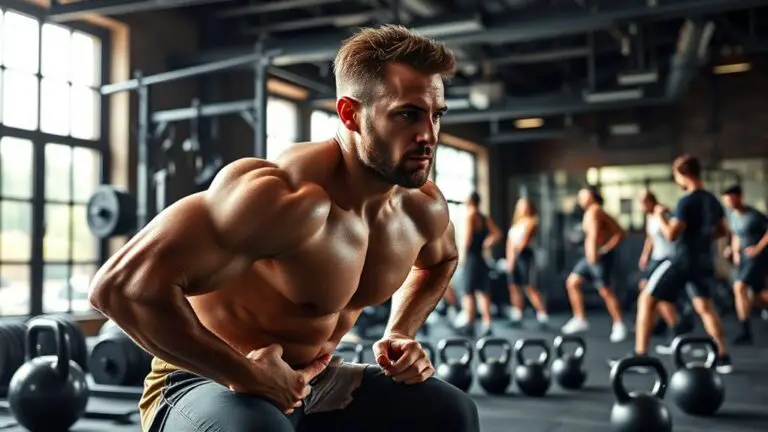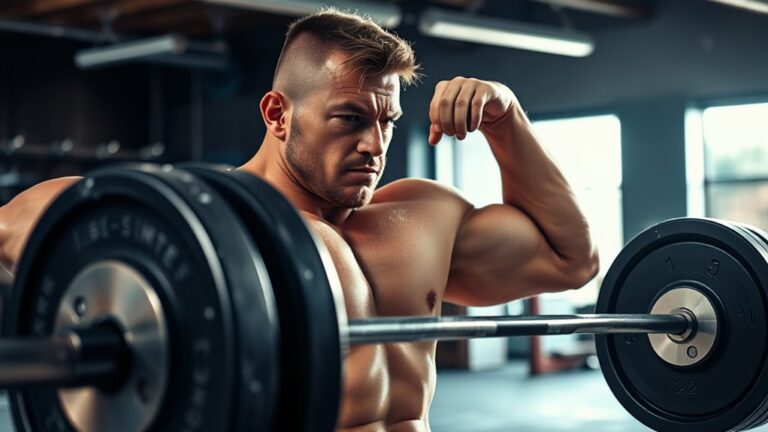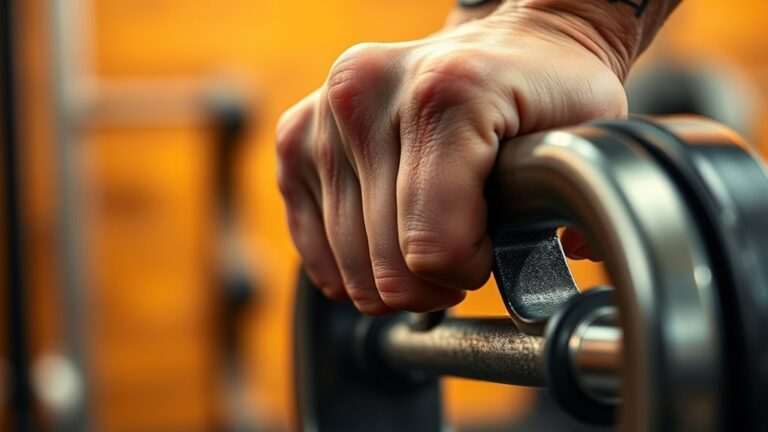The Best Gym Training Routines of Olympic Athletes
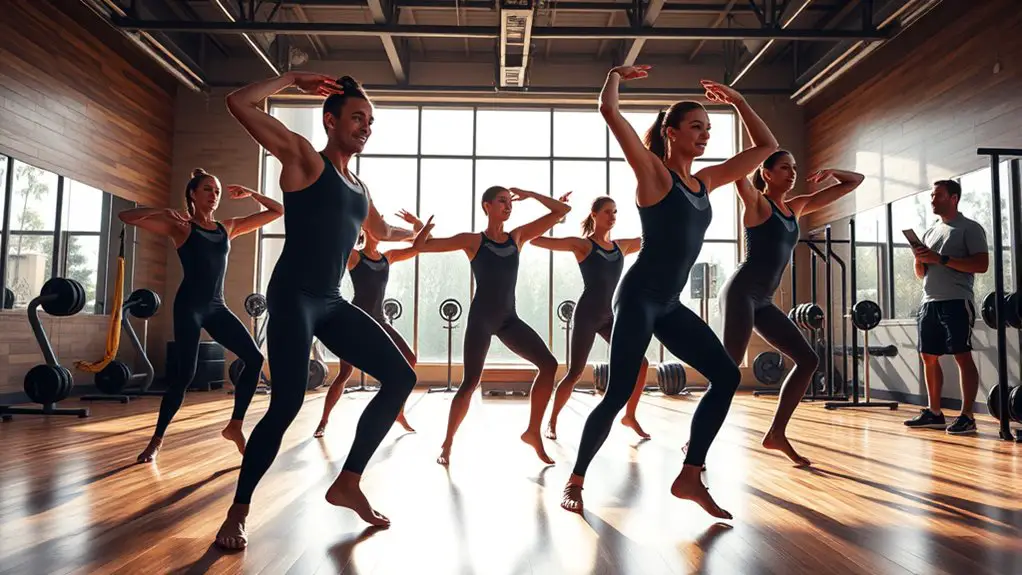
Olympic athletes follow rigorous gym training routines that combine strength training, endurance workouts, and sport-specific drills to optimize performance. You’ll focus on compound movements and progressive overload to build explosive power, while also integrating high-intensity intervals to enhance stamina. Flexibility and mobility work are essential for injury prevention and improved efficiency. Recovery strategies, including proper nutrition and hydration, fuel your training. Keep pushing your limits, and you’ll uncover techniques that can elevate your performance even further.
The Importance of Functional Training in Olympic Sports
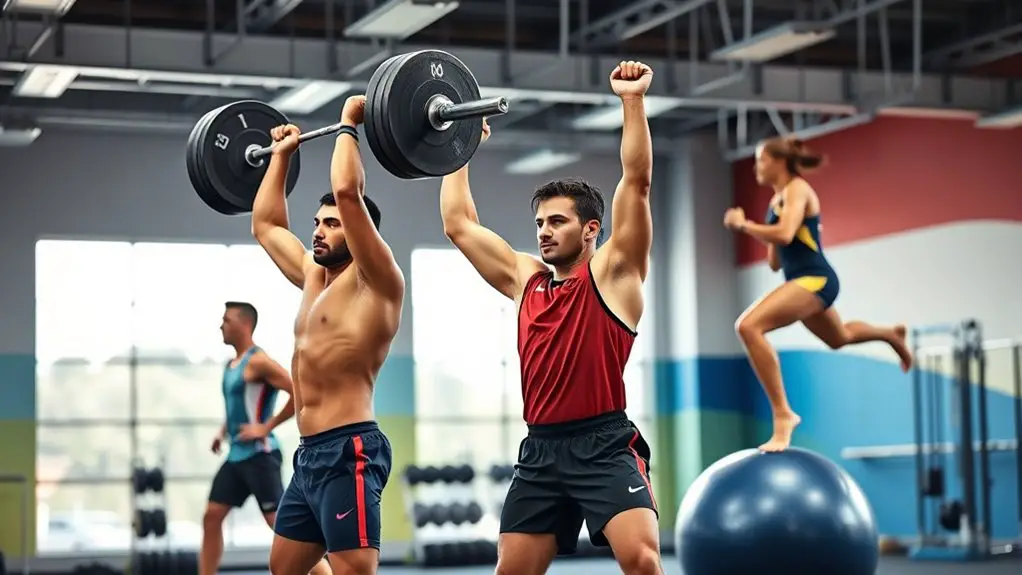
When you think about Olympic athletes, it’s easy to envision their incredible strength and speed, but what’s often overlooked is the critical role of functional training in their routines. Functional fitness focuses on movements that mimic everyday activities, enhancing your athletic performance and overall efficiency. By integrating this type of training, you’re not just building muscle; you’re improving coordination, balance, and agility, which are essential for success in any sport.
Moreover, functional training helps prevent injuries by strengthening stabilizing muscles and improving joint mobility. This means you can train harder and recover faster, giving you a competitive edge. Whether you’re sprinting, jumping, or swimming, the principles of functional fitness guarantee that your body works as a cohesive unit, maximizing your potential.
Strength Training Techniques for Elite Athletes
Strength training serves as the backbone of an elite athlete’s conditioning program, providing the foundation for explosive power and endurance. To maximize your performance, you’ll want to incorporate powerlifting techniques alongside Olympic lifting. These methods are designed to build strength, promote muscle hypertrophy, and enhance overall athleticism.
Focusing on compound movements like squats, deadlifts, and bench presses can considerably boost your functional strength. Olympic lifting, with its dynamic movements like the clean and jerk, not only improves power but also enhances coordination and balance.
Incorporate progressive overload to guarantee continuous improvement; gradually increase weights or intensity to challenge your muscles. This approach not only builds raw strength but also contributes to the resilience needed in competition.
Endurance Workouts: Building Stamina for Competition
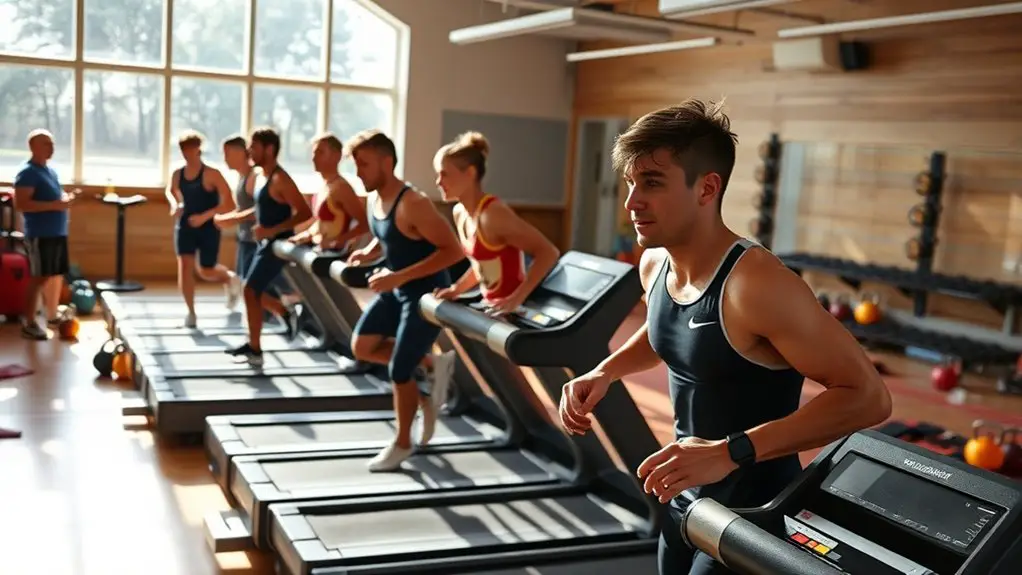
To excel in competition, you need a solid endurance foundation that combines aerobic base development with high-intensity intervals. These elements not only enhance your stamina but also improve your performance under pressure. Don’t forget that proper recovery and nutrition play essential roles in maximizing your results and keeping you at your peak.
Aerobic Base Development
Although you may not see immediate results, developing a solid aerobic base is vital for enhancing your endurance and overall performance in competition. Focus on aerobic threshold training, which helps you improve your body’s ability to sustain higher intensity efforts over time. By incorporating longer, steady-state workouts, you’ll boost your aerobic capacity enhancement, allowing you to perform better during competitions. Aim for consistent sessions that gradually increase in duration and intensity, pushing your limits while allowing adequate recovery. Remember, this foundation is essential; it supports not just your stamina but also your ability to recover between high-intensity efforts. Stay committed, and you’ll notice improvements in your endurance that can make all the difference when it counts most on competition day.
High-Intensity Intervals
Building on your aerobic base, high-intensity interval training (HIIT) serves as a powerful tool for enhancing your stamina and performance in competition. By incorporating interval training into your routine, you’re not just pushing your limits; you’re engaging in metabolic conditioning that drives your body to adapt and excel. These intense bursts of effort followed by brief recovery periods can greatly improve your aerobic capacity and speed. As you challenge yourself with varied intensities, you’ll notice quicker recovery times and increased endurance, allowing you to maintain peak performance under pressure. Embrace HIIT as a cornerstone of your training. It’s about maximizing efficiency, so you get the most out of every session, ultimately leading to success in your competitive endeavors.
Recovery and Nutrition
While you push your limits during endurance workouts, recovery and nutrition play crucial roles in ensuring that your body can adapt and thrive. Implementing active recovery techniques, like light jogging or swimming, helps reduce muscle soreness and enhances overall performance. Additionally, mastering nutritional timing can optimize your energy levels and recovery rate.
| Nutritional Timing | Active Recovery Techniques | Benefits |
|---|---|---|
| Pre-Workout Fuel | Light Jogging | Boosts performance |
| Post-Workout Meal | Swimming | Aids muscle repair |
| Mid-Workout Snacks | Yoga | Increases flexibility |
| Hydration | Foam Rolling | Reduces tension |
Sport-Specific Drills: Tailoring Training to Individual Events
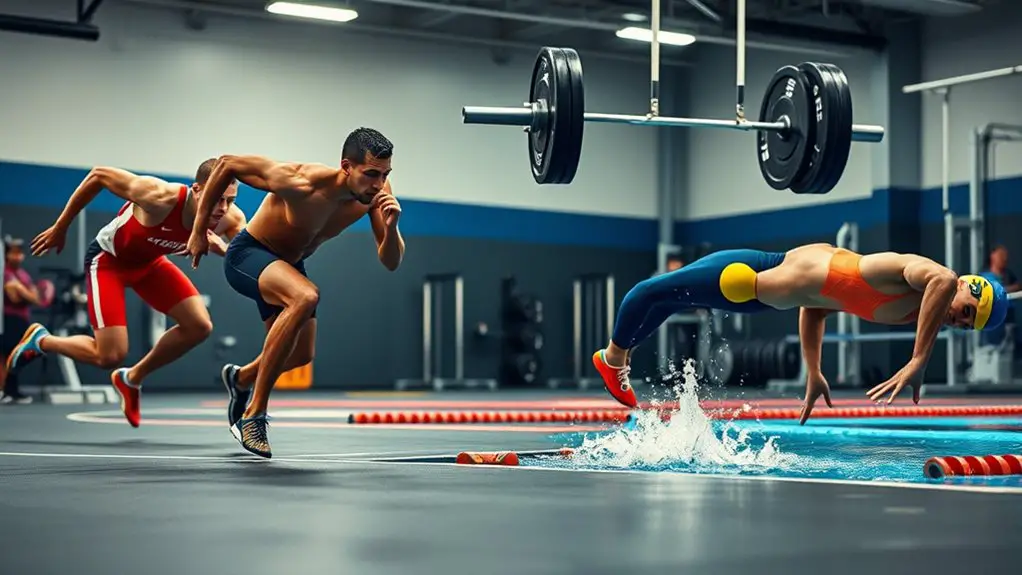
When it comes to excelling in your sport, focusing on event-specific drills is essential. By honing in on skill development, strength conditioning, and effective recovery strategies, you’ll optimize your performance and reduce the risk of injury. Tailoring your training to your unique event not only enhances your abilities but also sets you on the path to achieving your goals.
Event-Specific Skill Development
To excel in Olympic events, athletes must engage in event-specific skill development that hones their unique abilities and techniques. This focused training enhances skill acquisition and technique refinement, allowing you to outperform the competition. Here’s how to tailor your training effectively:
- Drills for Precision: Use repetitive practice to master specific movements.
- Video Analysis: Study your form to identify areas for improvement.
- Simulated Competitions: Mimic real event conditions to build mental resilience.
- Feedback from Coaches: Regularly seek advice to refine your techniques.
- Targeted Practice Sessions: Concentrate on the skills that matter most for your event.
Strength and Conditioning Focus
Building on the foundation of event-specific skill development, strength and conditioning play a pivotal role in enhancing your performance in Olympic events. By implementing a strategic strength periodization plan, you can optimize your training cycles to peak at the right moment. Each conditioning phase should be tailored to your specific sport, ensuring that you’re building the necessary strength and endurance for your unique demands. For instance, sprinters might focus on explosive power, while endurance athletes emphasize stamina and aerobic capacity. Integrating sport-specific drills into these phases keeps your training relevant and effective. Remember, consistency in your strength and conditioning regimen translates directly to improved performance and competitive edge. Stay committed, adapt as needed, and watch your results soar.
Recovery and Injury Prevention
While rigorous training is essential for peak performance, recovery and injury prevention are equally critical components that shouldn’t be overlooked. Tailoring your recovery routine can greatly enhance your performance and longevity in your sport. Consider integrating these strategies into your regimen:
- Active recovery: Engage in low-intensity exercises to promote blood flow.
- Stretching routines: Focus on flexibility to reduce muscle tightness.
- Nutrition: Fuel your body with the right nutrients for ideal recovery.
- Hydration: Maintain fluid balance to support recovery processes.
- Injury management: Address any niggles early to prevent escalation.
The Role of Flexibility and Mobility in Performance
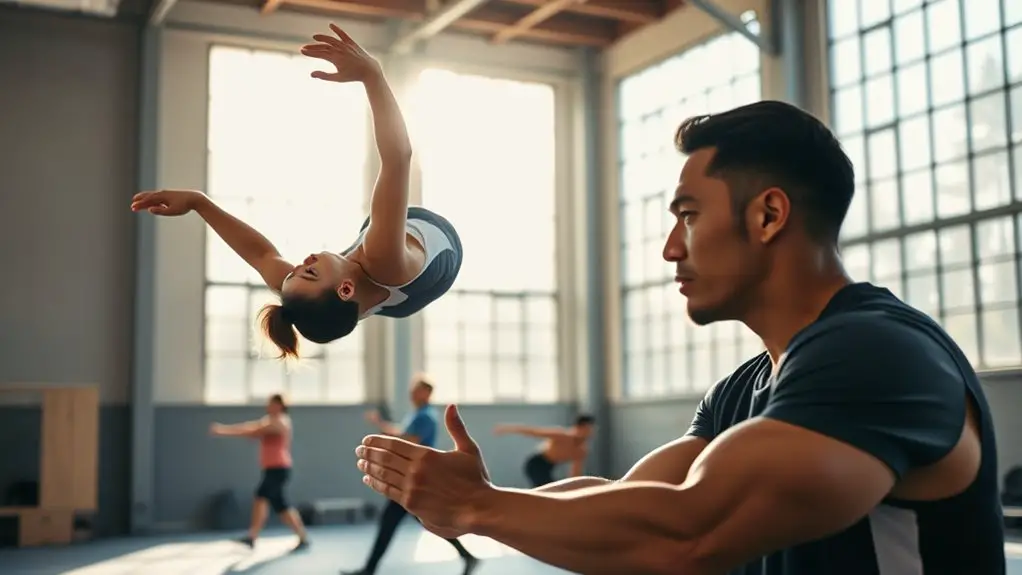
Flexibility and mobility are often overlooked components in the training routines of Olympic athletes, yet they’re essential for optimizing performance. When you prioritize these elements, you’re not just enhancing your range of motion; you’re also improving your overall athletic efficiency. Dynamic stretching, in particular, plays a vital role in preparing your muscles and joints for the demands of intense training and competition. By incorporating dynamic stretches into your warm-up, you can markedly increase your joint mobility, allowing for smoother and more explosive movements.
As an athlete, remember that the benefits of flexibility extend beyond just physical performance; they also contribute to injury prevention, enabling you to push your limits safely. So, don’t underestimate the power of flexibility and mobility. Make them integral to your routine, and you’ll see improvements not just in your performance but also in your confidence, ultimately setting you on the path to achieving your athletic goals.
Recovery Strategies: Essential for Athlete Longevity
Recovery strategies are essential for maintaining peak performance and ensuring longevity in an athlete’s career. Implementing effective recovery methods not only enhances your performance but also protects you from injuries. Here are some strategies you should consider:
Recovery strategies are crucial for athletes to sustain peak performance and extend their careers while minimizing injury risk.
- Active recovery: Engage in low-intensity workouts to promote blood flow.
- Sleep optimization: Prioritize quality sleep to enhance muscle repair and cognitive function.
- Mental recovery: Incorporate mindfulness or meditation techniques to reduce stress and improve focus.
- Hydration strategies: Maintain fluid balance to support overall performance and recovery.
- Massage therapy and foam rolling: Use these techniques to relieve muscle tension and promote recovery.
Nutrition and Supplementation: Fueling the Training Regimen

To achieve ideal performance, focusing on nutrition and supplementation is essential for any athlete’s training regimen. Striking the right macronutrient balance fuels your energy management and optimizes performance. Prioritize pre-workout fueling with quality carbohydrates and proteins to enhance energy levels. Implement hydration strategies throughout your training to maintain peak performance and prevent fatigue.
Post-workout recovery is equally important; consuming a well-timed meal within 30 minutes helps replenish glycogen stores and aids muscle repair. Pay attention to nutrient timing—this can greatly affect your results. Incorporate dietary supplements wisely, as they can fill nutritional gaps but shouldn’t replace whole food choices.
Frequently Asked Questions
How Do Olympic Athletes Maintain Mental Focus During Training?
Maintaining mental focus during training’s like tuning a fine instrument; it requires precision and practice. You can enhance your concentration by using visualization techniques, imagining yourself achieving your goals in vivid detail. Additionally, incorporating mindfulness practices, such as meditation, helps center your thoughts and reduce distractions. By consistently applying these methods, you’ll not only improve your focus but also boost your overall performance, turning training sessions into powerful stepping stones toward success.
What Role Does Sleep Play in an Athlete’S Performance?
Sleep plays an essential role in your performance, acting as a foundation for effective recovery strategies. It’s during sleep that your body repairs muscles, consolidates memories, and regulates hormones. By prioritizing sleep benefits, you’ll enhance your focus, energy, and overall athletic ability. When you get enough rest, you’re not just recovering; you’re setting yourself up for success. Remember, better sleep means better performance, so don’t underestimate its power in your training regimen.
How Do Athletes Prevent Overtraining and Burnout?
To prevent overtraining and burnout, you need to prioritize recovery techniques alongside your training intensity. Incorporating rest days, active recovery, and proper nutrition can help your body rebound effectively. Listen to your body; if you’re feeling fatigued, it’s okay to dial back your workouts. Balancing intensity with recovery not only enhances performance but also keeps you mentally motivated. Remember, sustainable results come from smart training, not just pushing harder every day.
What Are Common Injuries in Olympic Training, and How Are They Addressed?
Imagine a finely tuned machine, where every part must function flawlessly. In Olympic training, common injuries like strains and tendonitis can disrupt this harmony. To prevent these issues, focusing on injury prevention techniques is essential—think proper warm-ups and strength conditioning. When injuries do occur, effective rehabilitation techniques, such as physical therapy and tailored recovery plans, can help restore that balance. By prioritizing both prevention and recovery, you’re setting yourself up for long-term success.
How Do Athletes Balance Training With Personal Life Commitments?
Balancing training with personal life commitments requires effective time management and strong family support. You need to prioritize your schedule, setting aside dedicated time for both training and family activities. Communicating your goals with loved ones fosters understanding and encouragement, making it easier to balance both worlds. Remember, achieving success isn’t just about the hours spent training but also about maintaining relationships that keep you motivated and grounded.



